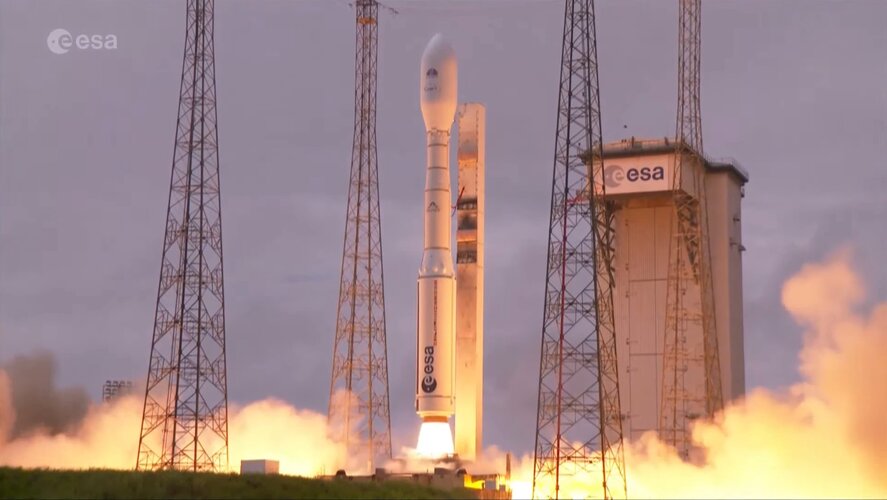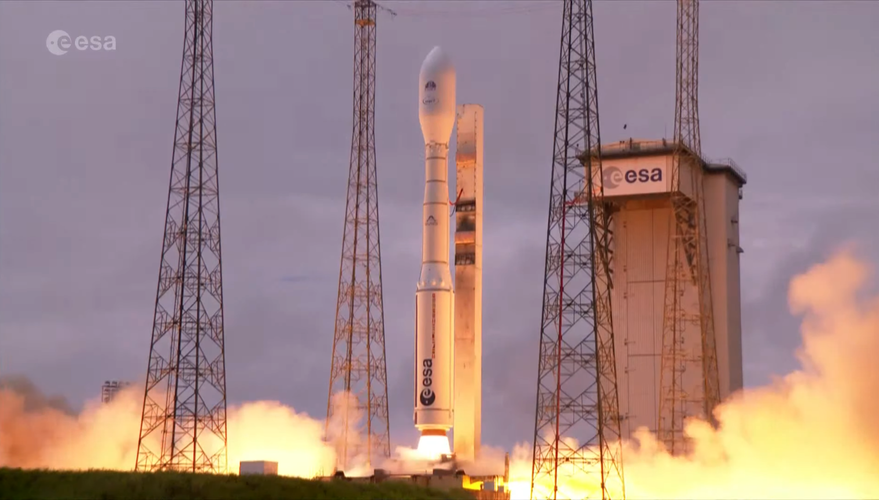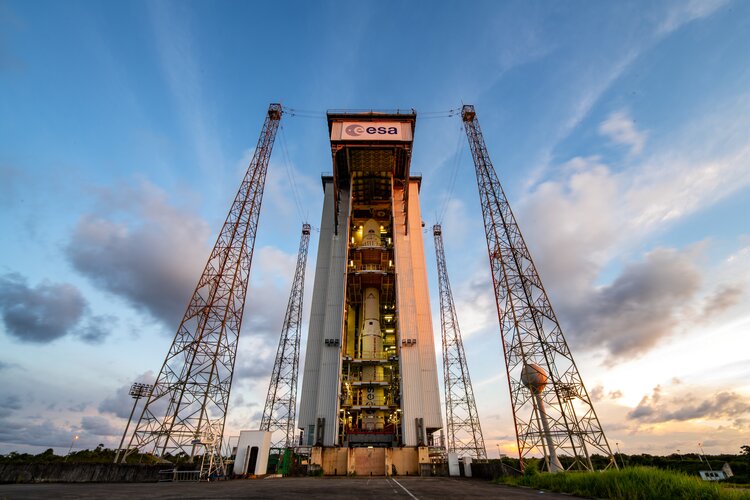
Copernical Team
Vega-C completes inaugural flight
 Flight VV21 lifted off from Europe's Spaceport in French Guiana at 15:13 CEST on Wednesday 13 July (14:13 BST/10:13 Kourou local time). This mission lasted about 2 hours and 15 minutes from liftoff to release of final payload and final burn of the AVUM+ upper stage engine.
Total payload mass at liftoff was approximately 474 kg: 296 kg for LARES-2, with the remainder being the six CubeSats,
Flight VV21 lifted off from Europe's Spaceport in French Guiana at 15:13 CEST on Wednesday 13 July (14:13 BST/10:13 Kourou local time). This mission lasted about 2 hours and 15 minutes from liftoff to release of final payload and final burn of the AVUM+ upper stage engine.
Total payload mass at liftoff was approximately 474 kg: 296 kg for LARES-2, with the remainder being the six CubeSats, Europe's upgraded Vega space launcher makes inaugural flight

ESA fully cuts Mars mission ties with Russia, angering Moscow

The European Space Agency has officially terminated cooperation with Russia on a mission to put a rover on Mars, with Russia's space chief furiously responding by banning cosmonauts on the ISS from using a Europe-made robotic arm.
The ESA had previously suspended ties on the joint ExoMars mission, which had planned to use Russian rockets to put Europe's Rosalind Franklin rover on the red planet to drill for signs of life, due to Russia's invasion of Ukraine.
ESA Director-General Josef Aschbacher tweeted on Tuesday that because the war and resulting sanctions "continue to prevail", the agency would "officially terminate" ties with Russia on ExoMars and its landing platform.
The firebrand head of Russian space agency Roscosmos Dmitry Rogozin issued an angry response.
"Has the head of the European Space Agency thought about the work of thousands of scientists and engineers in Europe and Russia which has been ended by this decision? Is he prepared to answer for sabotaging a joint Mars mission?" Rogozin said on Telegram.
SIRI-2 to qualify technologies for radiation detection in space

U.S. Naval Research Laboratory scientists launched the second Strontium Iodide Radiation Instrument (SIRI-2) instrument in December 2021 onboard Space Test Program (STP) Sat-6. SIRI-2, a gamma-ray spectrometer, will demonstrate the performance of europium-doped strontium iodide gamma ray detection technology with sufficient active area for Department of Defense (DoD) operational needs.
The first SIRI mission was launched Dec.
Space weather will delay your trains

Fluctuations in space weather are disrupting train signals and causing significant delays. A project investigating the effect of solar storms on railway signals will be presented this week at the National Astronomy Meeting (NAM 2022) by Cameron Patterson, a Ph.D. student at Lancaster University.
The sun's tendency to affect technology on Earth, as well as in space, is known as space weather. In railways, electric currents caused to flow in the Earth by solar activity can interfere with the normal operation of signals, turning green signals to red even when there is no train nearby.
Patterson says: "Most of us have at one point heard the dreaded words: 'your train is delayed due to a signaling failure,' and while we usually connect these faults to rain, snow and leaves on the line, you may not have considered that the sun can also cause railway signals to malfunction.
Vega-C liftoff
 Video:
00:06:42
Video:
00:06:42
Flight VV21 clears the launch pad to begin the inaugural mission of ESA’s new Vega-C rocket from Europe’s Spaceport in French Guiana.
Highlights of the inaugural Vega-C launch
 Video:
00:02:35
Video:
00:02:35
ESA’s newest launch system has faced its first full validation test, carrying LARES-2, a scientific mission of the Italian space agency ASI, and a secondary payload package of French, Italian and Slovenian research CubeSats.
Vega-C successfully completes inaugural flight

ESA’s new Vega-C rocket has completed its inaugural flight, placing main payload LARES-2 – a scientific mission of the Italian Space Agency ASI – into its planned orbit. Six research CubeSats from France, Italy and Slovenia flew as secondary payloads. The launch caps a multi-year effort by ESA, prime contractor Avio and industrial partners in 13 ESA member states to build on the heritage of its predecessor, Vega.
Vega-C: watch the launch

ESA’s new Vega-C rocket is nearly ready for its 13 July inaugural flight. You can follow live on ESA Web TV - EN or IT
Flight VV21 will now lift off as soon as 14:13 CEST, pending suitable conditions for launch.
Broadcast is now live - EN or IT
14:13 CEST/13:13 BST/12:13 UTC/09:13 Kourou – liftoff
Undead planets: the unusual conditions of the first exoplanet detection
 The first ever exoplanets were discovered 30 years ago around a rapidly rotating star, called a pulsar. Now, astronomers have revealed that these planets may be incredibly rare. The new work will be presented tomorrow (Tuesday 12 July) at the National Astronomy Meeting (NAM 2022) by Iuliana Ni?u, a PhD student at the University of Manchester.
The processes that cause planets to form, and s
The first ever exoplanets were discovered 30 years ago around a rapidly rotating star, called a pulsar. Now, astronomers have revealed that these planets may be incredibly rare. The new work will be presented tomorrow (Tuesday 12 July) at the National Astronomy Meeting (NAM 2022) by Iuliana Ni?u, a PhD student at the University of Manchester.
The processes that cause planets to form, and s 































